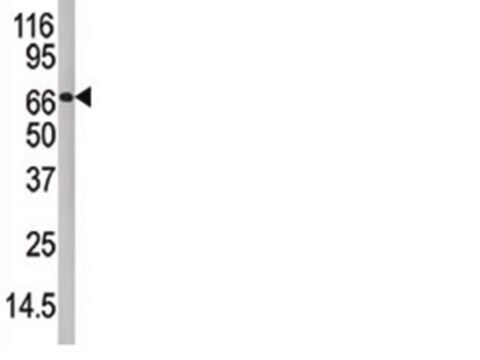おすすめの製品
由来生物
hamster
品質水準
抗体製品の状態
purified antibody
抗体製品タイプ
primary antibodies
クローン
3C2, monoclonal
分子量
calculated mol wt 17.9 kDa
observed mol wt ~16 kDa
精製方法
using protein G
化学種の反応性
mouse
包装
antibody small pack of 100
テクニック
western blot: suitable
アイソタイプ
IgG
エピトープ配列
Unknown
タンパク質IDアクセッション番号
UniProtアクセッション番号
保管温度
2-8°C
遺伝子情報
mouse ... Isg15(100038882)
特異性
Clone 3C2 is an Armenian Hamster monoclonal antibody that detects Ubiquitin-like protein ISG15.
免疫原
His-tagged full-length recombinant mouse Ubiquitin-like protein ISG15.
アプリケーション
Quality Control Testing
Isotype testing: Identity confirmation by isotyping test.
Isotyping Analysis: The identity of this monoclonal antibody is confirmed by isotyping test to be Armenian hamster IgG.
Tested Applications
Western Blotting Analysis: A 1:250 dilution from a representative lot detected ISG15 in primary mouse embryonic fibroblasts infected with Chikungunya virus.
Western Blotting Analysis: A representative lot detected ISG15 in Western Blotting applications (Lenschow, D.J., et al. (2005). J Virol. 79(22):13974-83; Lenschow, D.J., et al. (2007). Proc Natl Acad Sci USA. 104(4):1371-6; Fan, J-B., et al. (2015). Sci Rep. 5:12704).
Note: Actual optimal working dilutions must be determined by end user as specimens, and experimental conditions may vary with the end user.
Isotype testing: Identity confirmation by isotyping test.
Isotyping Analysis: The identity of this monoclonal antibody is confirmed by isotyping test to be Armenian hamster IgG.
Tested Applications
Western Blotting Analysis: A 1:250 dilution from a representative lot detected ISG15 in primary mouse embryonic fibroblasts infected with Chikungunya virus.
Western Blotting Analysis: A representative lot detected ISG15 in Western Blotting applications (Lenschow, D.J., et al. (2005). J Virol. 79(22):13974-83; Lenschow, D.J., et al. (2007). Proc Natl Acad Sci USA. 104(4):1371-6; Fan, J-B., et al. (2015). Sci Rep. 5:12704).
Note: Actual optimal working dilutions must be determined by end user as specimens, and experimental conditions may vary with the end user.
ターゲットの説明
Ubiquitin-like protein ISG15 (UniProt: Q64339; also known as Interferon-induced 15 kDa protein, Interferon-induced 17 kDa protein, IP17, Ubiquitin cross-reactive protein) is encoded by the Isg15 (also known as G1p2, Ucrp) gene (Gene ID: 100038882) in murine species. ISG15 is a disulfide-linked homodimeric, interferon-induced protein that plays a key role in host antiviral response. It is reported to exist in three distinct states: free form, released into the extracellular space, and as conjugated to target proteins. It contains two ubiquitin-like domains (aa 2-76 and 77-155) that are essential for its efficient conjugation to cellular proteins. Ubiquitin-like 2 domain is essential for the first two steps allowing the linking of ISG15 to the E1 and E2 enzymes while Ubiquitin-like 1 domain is essential for the E3-mediated transfer of ISG15 from the E2 to the lysine residues of the target protein. It also requires its C-terminal LRLRGG motif to form intracellular conjugates. ISG15 plays key role in the innate immune response to viral infection either via its conjugation to a target protein (ISGylation) or via its action as a free or unconjugated protein. ISGlylation is reported to involves a cascade of enzymatic reactions involving E1, E2, and E3 enzymes that catalyze the conjugation of ISG15 to a lysine residue in the target protein. Some of the target proteins of ISG15 include JAK1, ERK1, ERK2, STAT5A, TRIM25, and globin. The secreted form is also known to induce natural killer cell proliferation, act as a chemotactic factor for neutrophils, and act as a IFN -inducing cytokine. The secreted form acts through the integrin ITGAL/ITGB2 receptor to initiate activation of SRC family tyrosine kinases including LYN, HCK and FGR that leads to secretion of IFN and IL-10. S-nitrosylation of ISG15 can decrease its dimerization, thereby increasing the availability as well as the solubility of monomeric ISG15 for its conjugation to cellular proteins. (Ref.: Perng, Y-C., and Lenschow, DJ. (2018). Nat. Rev. Microbiol. 16(7); 423-439; Lenschow, DJ., et al. (2007). Proc. Natl. Acad. Sci, USA. 104(4); 1371-1376; Lenschow, DJ., et al. (2005). J. Virol. 79(22); 13974-13983).
物理的形状
Purified Armenian hamster monoclonal antibody IgG in buffer containing 0.1 M Tris-Glycine (pH 7.4), 150 mM NaCl with 0.05% sodium azide.
再構成
0.5 mg/mL. Please refer to guidance on suggested starting dilutions and/or titers per application and sample type.
保管および安定性
Recommended storage: +2°C to +8°C.
その他情報
Concentration: Please refer to the Certificate of Analysis for the lot-specific concentration.
免責事項
Unless otherwise stated in our catalog or other company documentation accompanying the product(s), our products are intended for research use only and are not to be used for any other purpose, which includes but is not limited to, unauthorized commercial uses, in vitro diagnostic uses, ex vivo or in vivo therapeutic uses or any type of consumption or application to humans or animals.
適切な製品が見つかりませんか。
製品選択ツール.をお試しください
保管分類コード
12 - Non Combustible Liquids
WGK
WGK 1
引火点(°F)
Not applicable
引火点(℃)
Not applicable
適用法令
試験研究用途を考慮した関連法令を主に挙げております。化学物質以外については、一部の情報のみ提供しています。 製品を安全かつ合法的に使用することは、使用者の義務です。最新情報により修正される場合があります。WEBの反映には時間を要することがあるため、適宜SDSをご参照ください。
Jan Code
MABF2247-100UG:
MABF2247-25UG:
試験成績書(COA)
製品のロット番号・バッチ番号を入力して、試験成績書(COA) を検索できます。ロット番号・バッチ番号は、製品ラベルに「Lot」または「Batch」に続いて記載されています。
ライフサイエンス、有機合成、材料科学、クロマトグラフィー、分析など、あらゆる分野の研究に経験のあるメンバーがおります。.
製品に関するお問い合わせはこちら(テクニカルサービス)



![2,2′-メチレンビス[(4S)-4-tert-ブチル-2-オキサゾリン] 99%](/deepweb/assets/sigmaaldrich/product/structures/316/483/d76fb8bf-5216-440e-a409-771970cad43d/640/d76fb8bf-5216-440e-a409-771970cad43d.png)